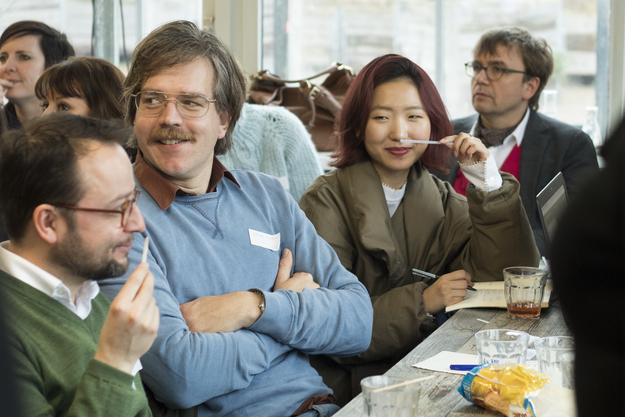In January 2018, Mediamatic teamed up with the IFF, Saskia Wilson-Brown from the Institute for Art and Olfaction, Klara Ravat, Caro Verbeek, and Frank Bloem to advance our language, classification, and knowledge on scents that are so often indescribable. The lack of linguistic expression for scents makes it more difficult for the people to delve into the wonders of smell culture. Along with other olfaction enthusiasts, they’ve all together concluded that the language for smell was richer in the past and in foreign languages. More commonly, smell is now often expressed through movement and our experiences of smell can easily be mentally manipulated.
Smelling in groups during Hackathon -

From the Saturday morning session we learned that there is no consensus about smells, even amongst people that are busy with scents on a daily basis.
From my own practice in working with Airbnb workshop-guests from all over the world I discovered the ability of raw ingredients to change nature. When I think a certain smell has a horse manure-like presence someone else can register an anise-like smell. And when I smell it again with that knowledge, I do also smell anise.
The questions that arises are: is this a physical or a mental effect? Do smells have different ways of presenting themselves? Are there more sides to the same smell, or can the brain be fooled so easily?
If the sense of smell is such a subjective experience, it must be impossible to communicate smells on a non-odorous way. While on the other hand, the opposite may also be true. Because smells are so open to interpretation, they can easily be bended into a certain direction. Package, story, branding, video etc are essential in the way smells are interpreted and received.

We looked at other products that hide their quality until you unpack, and we came up with the avocado as a an example. The way of finding the ripest avocado is by touching them all, and find the one that is in between hard and soggy. While touching, you come across avocados that were so intensely squashed that you can feel the imprints from other customers. Because of their texture and colour, they almost ask for it.
We discovered a similarity in smell and touch. The two are a bit overlooked in our visually an audio obsessed world, but the vocabulary of texture is quite rich and many smells might be easily categorized by tactile descriptions. We looked into contemporary internet trends such as chewing on washing agent tab-cushions, or the recent outburst of youtubers touching different textures.
Some of the senses that were maybe a bit overlooked in the digitalized world are making their entrance to the youtube and social media community. We can learn from the ways these sense-enthusiasts communicate the sensations on their youtube channels. The lighting, the sound the hands and nails, all these elements generate an idea about the sensation in the heads of the spectators.
Although for smell this might be a bit more complicated to do, but there are many more ways of communicating smells other than only by the colour of a fabric softener or an erotic title on a perfume bottle. Elements from the tactile world can help in exploring this undefined world of essences.
Frank Bloem
www.thesnifferoo.com
info@thesnifferoo.com

